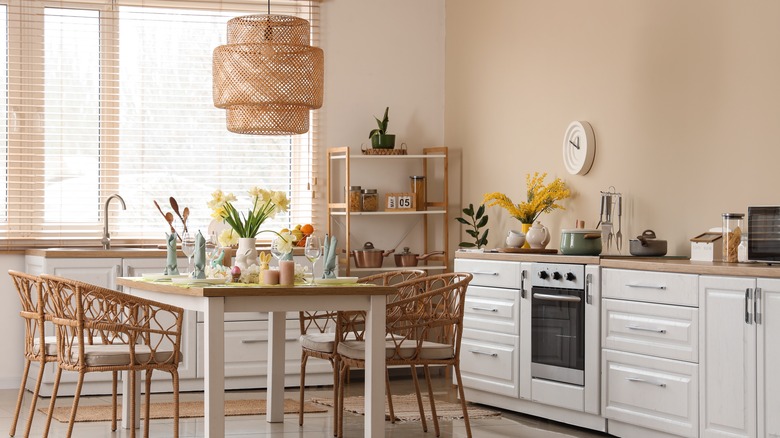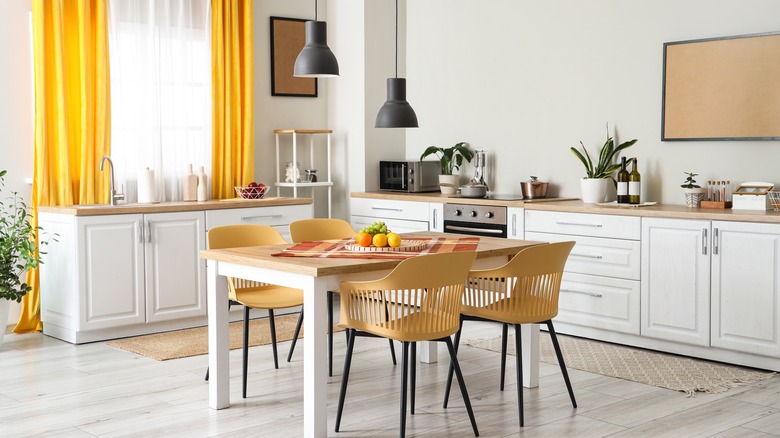The New Neutrals Taking Over Transitional Kitchens
Do you love the coziness and lived-in feel of traditional kitchens, but are also drawn to the sleek, futuristic appeal of modern aesthetics? That's where transitional decor comes in. A common solution for those who like elements from the two seemingly opposite design styles, transitional design blends modern and traditional touches to keep your home warm and inviting, yet chic and on-trend. So, where do you begin when integrating this style into a room? One of its key components is a neutral color palette. Often associated with whites and creams, neutral colors are now expanding to include hues outside of that color family — especially in transitional kitchen design.
Shades of grays, blues, beiges, and yellows have become go-to options for homeowners and interior designers looking to create a transitional kitchen. Subdued hues of these colors are cooking up a frenzy in these spaces, as they pair well with a variety of floors and surfaces, can further emphasize other bold colors and textures, and add a touch of style to a kitchen as-is.
How to make soft grays and subdued blues work
The middle ground between white and black, a gray color scheme is not uncommon for transitional kitchens. Both light and dark shades of gray help accentuate traditional-style cabinetry and appliances, as well as vintage accents. Gray walls, in particular, complement wooden cabinets and shelves, providing a modern backdrop. On that note, be sure to choose the best light gray wall colors for your kitchen to open up the space and promote a sense of calm in this often chaotic area.
Painting cabinets gray or installing new gray cabinetry is another popular choice for transitional kitchen design, thanks to the color's versatility and many undertones. Darker gray tones add refinement to your cooking area, while lighter grays evoke tranquility. Introduce dark gray countertops for an extra level of sophistication, or paint your kitchen island a similar hue to make everything cohesive.
If you want a little more color in your transitional kitchen, reach for subtle blue color swatches. Softer shades of blue offer similar calming effects as grays but are a hint more vibrant and eye-catching. Likewise, blue complements most other colors, making it a popular neutral. When used as a wall color, dark blue or navy pairs well with traditional wood cabinetry; meanwhile, paler blues reflect natural light and visually expand the space in your kitchen. Blue cabinetry, on the other hand, can tone down an overly bright room or, if leaning towards a lighter shade, add brightness to a darker kitchen.
Try beiges or say hello to mellow yellows
Beige is among the best neutral alternatives to white, as it closely resembles standard neutral tones. Considered timeless, beige has been having a resurgence within transitional kitchen design. Beige tones used on walls or as a backsplash can bring a sense of warmth to your kitchen, truly making it feel like the heart of the home. They're also great for offsetting sleek, modern appliances to create a cozy and traditional atmosphere. Beige hues are complementary to a variety of colors, so you won't have to worry about matching your countertop surface or existing wall paint. Amid white walls, beige cabinets can bring a pop of color without altering the neutrality of the kitchen. Set against black or darker surfaces and accented with metallic hardware, they can make the space a little more sophisticated.
A surprising new neutral, pale and mellow yellows join the list of colors versatile enough to pair with almost anything. Like its predecessors, yellow adds warmth, brightens, and opens up rooms, especially when reflecting natural lighting. The color is also known to stimulate appetite — hence, perfect as a backdrop for food preparation and eating areas. For less of a commitment to the bright color, adding yellow accent pieces (think bar stools, art, or window trim) to an existing traditional scheme can provide pops of color that give the room a modern touch.


